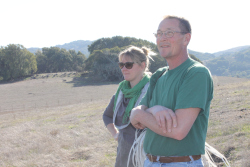Source: grist.com
Published: January 16, 2014

Shutterstock
When UC-Berkeley ecologist Whendee Silver first heard about the idea behind the Marin Carbon Project, she was pretty skeptical. The group wanted her to study the land they were ranching to see if putting compost on grasslands might stimulate the landscape to siphon carbon out of the atmosphere and incorporate it into the soil.
“I doubt I could measure it,” she told the group, which had assembled at Lawrence Berkeley Lab. “And you won’t like the results if I can.”
For years, ranchers have been drawn by the prospect of using their rangelands to soak up carbon. That would mean more grass, richer soil, and less planetary catastrophe. But hard science to support the idea has been lacking. Some range scientists suggested the idea was bunk.

John Wick and Lynette Niebrugge, soil scientist for the Marin Resource Conservation District.
Silver agreed to take on the project. Now, after five years of collecting data, she has been surprised by the results.
“It was quite possible that we might have found that you can’t sequester carbon in the soil. But we saw that you can,” she said. “And we could have found that trying to measure carbon captured in the soil could have been like looking for needles in a haystack. But it’s more like looking for bricks in a haystack.”
Green shoots in drought-ridden California.
At this point, she says, she’s cautiously optimistic: “This is a way that agriculture could move from being part of the problem to part of the solution.”
In contrast to Silver’s cautious optimism, John Wick, who is testing out the concept on his land, is exuberant.
